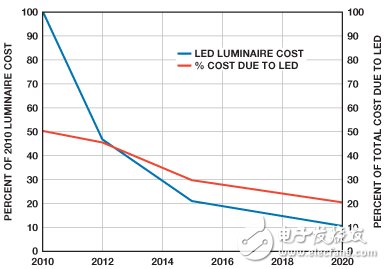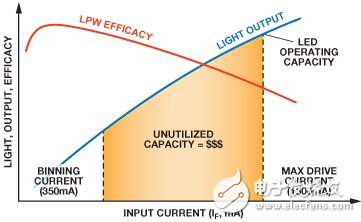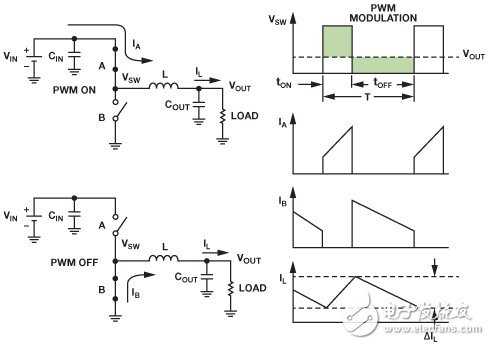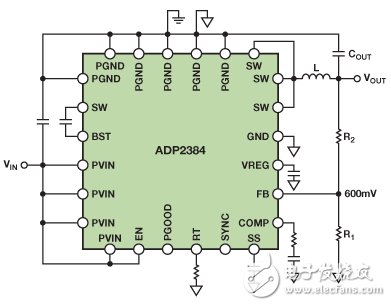With its long life and low power consumption, LED is expected to change the entire lighting industry, but the main obstacle to its rapid adoption is the high cost of the LED itself. The cost of LED luminaires (complete power lighting) varies, but the cost of LEDs typically accounts for about 25% to 40% of the cost of the entire luminaire, and is expected to still account for a high percentage over the next few years (Figure 1).

Figure 1. Segmentation of LED lamp costs
One way to reduce overall luminaire cost is to drive the LED at the highest possible DC current, to the extent permitted by product specifications. This current may be much higher than its "step current". This may result in a higher lumen/cost ratio if driven normally.

Figure 2. LED light output and efficiency versus drive current
However, this approach requires a higher current driver. Many solutions drive LEDs at low currents (<500 mA), but there are few high current (700 mA to 4 A) options. This phenomenon seems surprising because the semiconductor industry has a large number of DC-DC solutions with a capacity of 4 A, but they are designed to control the voltage instead of controlling the LED current. This article will explore some simple techniques for converting an off-the-shelf DC-DC buck regulator to a smart LED driver.
The buck regulator chops the input voltage and transmits it through the LC filter to provide a stable output, as shown in Figure 3. It uses two active components and two passive components. The active components are the switch "A" from the input to the inductor, and the switch (or diode) "B" from the ground to the inductor. The passive components are the inductor (L) and the output capacitor (COUT) which form an LC filter that reduces the ripple generated by the active components.

Figure 3. Basic Buck Solution
If the switch is internal, the buck is called a regulator. If the switch is external, it is called a controller. If both switches are transistors (MOSFET or BJT), then it is synchronous if the bottom switch is It is asynchronous using a diode implementation. These types of buck circuits have their own advantages and disadvantages, but synchronous buck regulators typically optimize efficiency, device count, solution cost, and board area. Unfortunately, synchronous buck regulators for driving high current LEDs (up to 4 A) are rare and expensive. This article uses the ADP2384 as an example to show how to modify the connection of a standard synchronous buck regulator to regulate the LED current.
The ADP2384 high efficiency synchronous buck regulator specifies an output current of up to 4 A with an input voltage of up to 20 V. Figure 4 shows the normal connection used to regulate the output voltage.

Figure 4. ADP2384 connected to regulate the output voltage
Waterproof RGB LED Dance acrylic Floor Display Screen for Wedding Party
These interactive display walls are applied in different purposes. This is a perfect audio/visual solution for commercial or
business purposes as well as for the educational purposes. It is often used for providing information to the viewers or audiences in the most interactive and effective way .
prospective customers. The interactive LED can be used IN retail stores, restaurants and other commercial spaces for giving information about their services and products.
1.Aluminum Structure Light Weight,good heat dissipation, good weather resistance, convenient transportation.
2.Imported PC Protrctive Surface, High Permeability, Strong Impact Resistance, Good anti-slip Effect
3.Strong Load Capacity The center of the panel has a load-bearing pivot,with a single panel bearing more then 1.2tons
Dance LED Display,Flexible Led Screen,Indoor Led Display Screen,Led Church Screen
Guangzhou Chengwen Photoelectric Technology co.,ltd , https://www.cwstagelight.com
